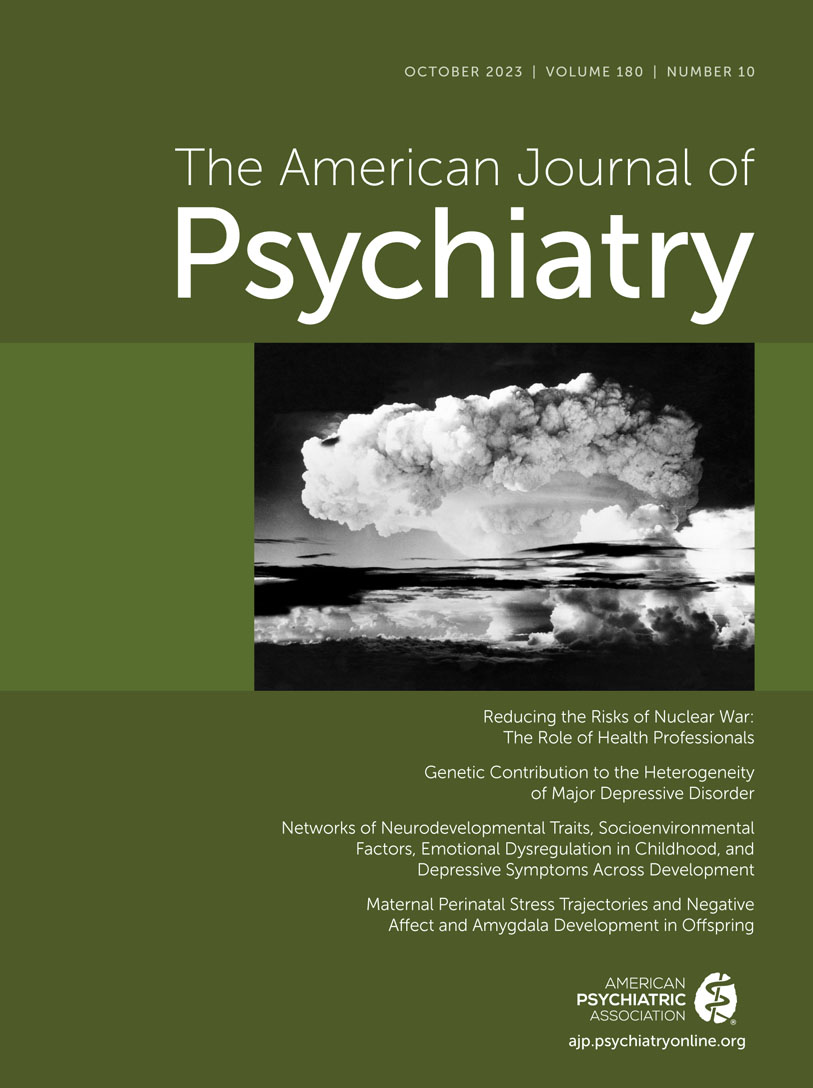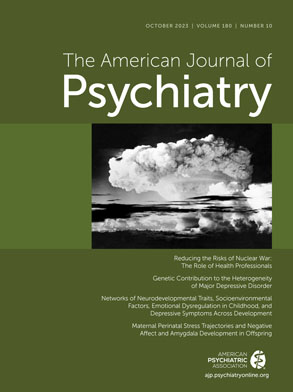Suicide is the second leading cause of death among 15- to 29-year-olds (
1), and a history of psychiatric disorders is one of the main risk factors. Hence, understanding the causes of and prevention of suicide has been an important focus of research and clinical practice, as exemplified by the many publications (over 8,000 in 2022 in PubMed) on this topic. Besides environmental and social factors, biological factors also contribute to suicide risk. The heritability of suicide is reported to be in a range similar to that of mood and anxiety disorders, with estimates from twin and family studies ranging from 30% to 55% (
2), and this genetic contribution has been supported by molecular genetic studies, especially genome-wide association studies (GWASs) (
3).
Genetic studies can contribute in two main areas: They can lead to discoveries of mechanisms and underlying biology, and they can be exploited clinically, such as for risk prediction, prediction of treatment outcome, or diagnostic stratification (
4). Especially in the area of discovery of the underlying biology, new tools, including single cell sequencing and other omics methods, as well as large publicly available data sets, now not only allow identification of candidate loci but also can point to disorders with shared genetics, uncover novel drug targets, and identify likely tissues or cell types implicated in the pathophysiology. Genetic studies thus offer a unique approach to gaining insight into the underlying biology of suicidal behavior, which, in its complexity, is uniquely human.
In this issue, Docherty et al. (
5) present a meta-analysis of the two largest GWASs of suicide attempt and death to date, with a total of over 950,000 individuals, of whom over 43,000 are cases from European, Asian, and East Asian ancestry admixture. The two initial GWASs included data from the International Suicide Genetics Consortium (ISGC), combining 18 international cohorts (
6), and from the Million Veteran Program, using electronic health record data for case definition (
7).
Coming from two nonoverlapping genome-wide significant loci in each of the original GWASs, the authors now report 12 risk loci at genome-wide significance and a SNP-based heritability ranging from close to 6% for the total sample to estimates close to 10% in some ancestries. In contrast to heritability in general, which estimates the proportion of phenotypic variation due to all genetic factors, SNP-based heritability focuses specifically on the contribution of the common single-nucleotide polymorphisms measured in GWASs (
8), but would not include heritability based on rare copy number variations, for example. SNP-based heritability is thus often lower than the estimated general heritability.
In addition to including different ancestries, the cohorts in this study also differed in how suicide attempt was assessed, and included military and civilian cohorts and different gender distributions. However, the genetic architecture was very comparable across cohorts, including for those in which cases had died from suicide. In fact, previous studies had specifically investigated the genetics of death by suicide and compared them to the genetics of suicide attempt, noting strong overlaps and correlations (
9), which also likely extend to suicidal ideation (
10). Despite this strong overlap, there may be loci more specific for suicide death, such as a locus mapping to neuroligin 1 (
NLG1), a gene encoding a cell adhesion protein expressed in the synapse and associated in other studies with autism spectrum disorder, schizophrenia, and neurodevelopmental delay. The associations with this locus appear to be rather specific for suicide death, as significance remained when conditioning for major depressive disorder as well as suicide attempt (
9).
While attempts to robustly disentangle the genetics of completed suicide versus suicidal behaviors are most likely still underpowered statistically, it is possible to start to disentangle common and separate genetics of suicide attempt and psychiatric disorders as well as other traits.
In this study, Docherty et al. report overlap with GWAS signals or genetic correlation with attention deficit hyperactivity disorder, insomnia, cognition, smoking, pain, and risky behavior or risk tolerance, confirming and extending findings from previous studies. Phenome-wide analyses indicate associations with psychiatric-, weight-, and immune-related traits. These correlations seem to be independent of the genetic risk for major depressive disorder and posttraumatic stress disorder. This is in contrast to genetic correlations of suicide attempt with schizophrenia, bipolar disorder, or neuroticisms that did not remain significant after conditioning for major depression and posttraumatic stress disorder, suggesting risk factors for suicide attempt both shared and distinct from psychiatric disorder. The study also implicates nonpsychiatric genetic risks in suicide attempt, such as several pulmonary health factors. All these genetic correlations can now serve as starting points for investigations trying to identify or to further explore risk markers. This can include the behavioral level, with potential targets for therapeutic intervention. These genetic findings also corroborate observations from other levels of investigations, such as previously reported connections between suicidal behavior and insomnia (
11) as well as risk taking or impulsivity (
12).
The analyses presented here also point to the fact that genes associated with suicidal behavior are enriched for those expressed in the brain as well as in the pituitary gland and lend additional support to a “brain-centric model of suicidal behavior” (
13), including for the role of the hypothalamic-pituitary-adrenal axis and neuroinflammation in suicide. For the latter, this meta-analysis showed associations with immune phenotypes in the phenome-wide associations, and gene set enrichment analyses identified overlapping immunologic signatures. In fact, a very large postmortem brain RNA expression analysis (
14), which included comparisons between patients who had died from suicide with violent versus nonviolent means, pointed to a role of purinergic signaling in microglia in suicide by violent means.
The biological findings reported by Docherty et al. benefited from the circumstance that the authors present a meta-analysis based on multi-ancestry cohorts in addition to a meta-analysis only within the largest ethnic group from European ancestry. The multi-ancestry approach led to the identification of three novel loci not identified in the European subset and also significantly improved the genetic predictions for suicide attempt across different ancestries using polygenic scores. This further underlines the importance of ongoing efforts to invest in increasing the diversity of genetic studies, as exemplified by the Global Biobank Meta-Analysis Initiative (
15) as well as initiatives of the Psychiatric Genomics Consortium (
16).
While the paragraphs above have tried to highlight how we can use genetic studies for discovery, exploiting these for clinical use is another possible avenue. Preventing suicidal thoughts and behaviors, especially among young people, is a public health priority. Previous studies have combined environmental risk factors and a polygenic score for suicide attempt for risk prediction (
17). Such predictions will benefit from improved scores, applicable to individuals of all ancestral backgrounds. While these scores have not yet reached clinical utility, they may in the future, and then we need to be prepared to ensure that information about genetic risk scores is distributed cautiously, with genetic counseling and with adequate safeguards (
18).
Overall, this largest genetic meta-analysis to date for suicide attempt has contributed to discovery of novel biology and has lent support to pathomechanistic hypotheses from other areas. It has also increased the robustness of polygenic scores associated with suicide attempt across ancestral groups. While it sometimes may appear that our field is inundated with GWASs and related genetic studies, one has to keep in mind that increased sample sizes and increased ancestral diversity also increase the robustness of the associations and, with this, the possibilities for discovery and exploitation.

